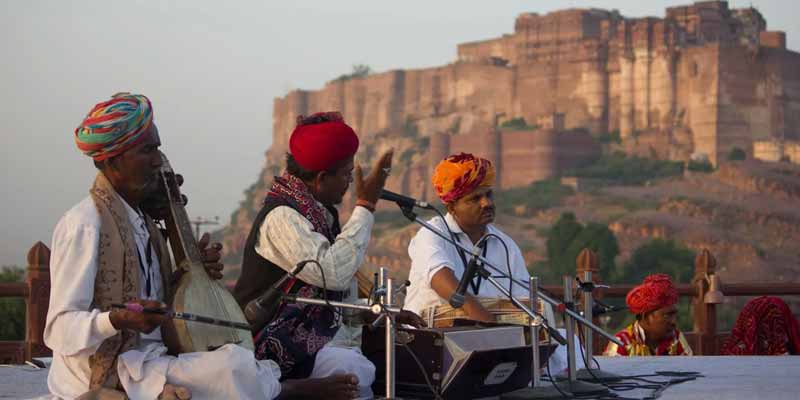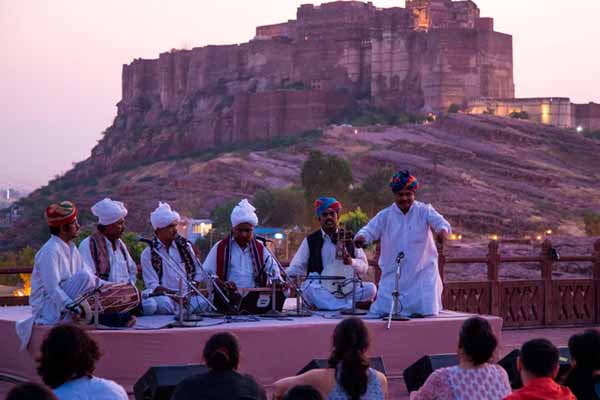RIFF Festival in Jodhpur The Rajasthan International Folk Festival (RIFF), held annually in Jodhpur, is a vibrant celebration of traditional folk music and arts that encapsulates the rich cultural heritage of Rajasthan. Hosted in the majestic Mehrangarh Fort, the festival usually takes place around the time of Sharad Purnima, the brightest full moon of the year in north India, typically in October.
RIFF Jodhpur has gained international acclaim for its unique blend of traditional and contemporary music, attracting artists and audiences from across the globe. The festival is endorsed by UNESCO as a “People’s Platform for Creativity and Sustainable Development,” highlighting its commitment to preserving cultural traditions while promoting sustainable practices within the arts.
The festival’s program features a wide array of performances including folk dances, puppet shows, and instrumental music sessions. One of the highlights is the series of dawn concerts that offer an ethereal experience of listening to live music as the sun rises over the city. RIFF also facilitates workshops and interactive sessions where artists share their skills and stories, promoting an exchange of ideas and fostering a deeper understanding of Rajasthani culture.
RIFF not only provides a stage for local talent but also works towards the revitalization of traditional arts by creating opportunities for folk artists. This celebration in the heart of Rajasthan provides a magical, musical escape and a deep dive into the heart of Indian folk culture Jodhpur Day Tours.

History of RIFF Festival in Jodhpur
The Rajasthan International Folk Festival (RIFF) in Jodhpur was inaugurated in 2007, conceived as a collaborative project to promote the rich cultural heritage of Rajasthan on an international platform. The idea for the festival originated from the desire to create a meeting point for local and international artists, and to celebrate and revitalize traditional folk music and arts, ensuring their preservation and continuation.
RIFF Festival in Jodhpur is held at the Mehrangarh Fort, one of India’s largest and most well-preserved forts. The venue itself adds a historical and dramatic backdrop to the performances, enhancing the overall experience. The fort, perched on a rocky hill above the city, provides a panoramic view of Jodhpur and has become synonymous with the festival.
The festival was founded under the patronage of the Maharaja of Jodhpur, Gaj Singh II, and is supported by two key organizations: the Mehrangarh Museum Trust and Jaipur Virasat Foundation. These organizations work together to provide a platform that supports the artistic expressions of local musicians, dancers, and artisans, alongside showcasing international artists who share the same ethos of cultural preservation.
RIFF occurs annually during the time of Sharad Purnima, the brightest full moon of the year, which is considered an auspicious time in the local calendar. This timing not only adds a spiritual dimension to the festival but also attracts audiences and performers from around the world, drawn by the magical combination of excellent weather and full moon-lit nights.
The festival has grown in stature and reputation over the years, drawing attention from international musicians, scholars, and tourists who are eager to experience authentic Rajasthani music and arts in a unique setting. The inclusion of interactive sessions, workshops, and special children’s programming ensures that the festival appeals to a wide demographic, while educational initiatives promote greater awareness of the cultural traditions of Rajasthan.
RIFF serves as a crucial link between the past and the present, providing a sustainable platform for folk artists to gain recognition and earn a livelihood, thereby ensuring that the rich traditions of Rajasthani culture are kept alive and thriving for future generations RIFF Festival in Jodhpur.
Here are some highlights of the Jodhpur RIFF festival
The Jodhpur RIFF (Rajasthan International Folk Festival) offers an eclectic and vibrant mix of music, culture, and arts under the starry skies of Jodhpur. Held at the majestic Mehrangarh Fort, the festival blends traditional Rajasthani music with global sounds, creating a unique cultural experience. Here are some of the key highlights of the festival:
- Rajasthani artist:
It has been invited to put on an amazing show, including Chiranji Kanji, Shamsuddin (Maand), Kamaycha Ghewar, Dare Khan Maganiyar, Anwar Manganiyar, Lakhs Khan Manganiyar Kadae Khan Lang, Pampa Khan Manganiyar, and Sawn Khan Manganiyar. This special event called the “Living Legends” series, will feature the musicians’ expertise with instruments like Sarangi and Vocals, Shehnai and Murli, and Sufi.
- Jayateerth Mevundi:
The Kirana Gharana has produced some of the finest singers. He is the main attention at the Jodhpur RIFF festival and is a professional in his Santvaani (words of saints) and Daasavani (words of devotees) classical music from Karnataka and Maharashtra.
- Sondorgo:
It’s a Hungarian band. The band performs lesser-known Serb-Croatian music that is performed by the local populations along the Danube River’s banks. Balkan and Gipsy music from all over the world, as well as the Danube. They use 17 instruments to perform a range of musical genres RIFF Festival in Jodhpur.
- Davy Sicard:
The Island of La Reunion is where Davy Sicard was born. renowned as “the Maloya mastermind” at times.
- Robust:
Ben Walsh will be joined by other accomplished percussionists. He is an accomplished Australian percussionist.
- Maru Tarang:
Jeff Lang and Bobby Singh are members of the Australian Rajasthani music group Maru Tarang, together with Rajasthani musicians Sin Lang and Bhungar Manganiyar.
- Bixiga 70:
Bixiga 70 is one of Brazil’s most beloved contemporary instrumental music ensembles. Their music, which incorporates jazz, samba, reggae, electronic ethnic carimbo, and other genres, is heavily influenced by both Brazil and Africa.
How to reach Jodhpur RIFF
Reaching the Rajasthan International Folk Festival (RIFF) in Jodhpur involves several travel options, depending on your starting location and preference for travel. Jodhpur is well-connected by air, road, and rail, making it accessible from major cities in India and beyond. Here’s how you can get there:
By Flights: The nearest airport to Jodhpur is Jodhpur Airport (JDH), also known as Maharaja International Airport. You can book a flight to Jodhpur from major cities in India. After arriving at the airport, you can hire a taxi or use local transportation to reach the festival venue RIFF Festival in Jodhpur.
By Train: Jodhpur is well-connected by train. The main railway station is Jodhpur Junction (JU). You can check the train schedules and book tickets to Jodhpur from various cities. Once you arrive at the railway station, you can take a taxi, auto-rickshaw, or other local transport options to reach the RIFF venue.
By Road: Jodhpur has good road connectivity and can be reached by road from nearby cities and states. You can travel by bus, car, or hired taxi. National highways and state highways connect Jodhpur to major locations. If you’re driving, you can use navigation apps or maps to guide you to the RIFF venue.
